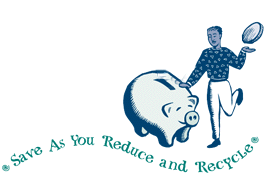General Public - Throw Away Less and Save
More Fact Sheets
Introduction | What is pay-as-you-throw? | Are there disadvantages to pay-as-you-throw? | What can I do?
Fact Sheet
530-F-96-028
April 1997
Introduction
 Do
you know how much you spend per month on electricity?
How about your gas utility? The person who pays the
bills in your household probably has a pretty good
idea. But do you know how much you spend on garbage?
Do
you know how much you spend per month on electricity?
How about your gas utility? The person who pays the
bills in your household probably has a pretty good
idea. But do you know how much you spend on garbage?
Each time your city or town sends a truck down your street to pick up your waste, it costs money. It costs money even if you drop your trash off at a local dump. Ultimately, you pay for this service, usually through your local taxes. And it's not likely that you have much control over the amount you pay, regardless of how much garbage you create.
There is a different system, however, under which residents are asked to pay for waste collection directly-based on the amount of garbage they actually generate. They're called "pay-as-you-throw" (PAYT) programs, and nearly 6,000 communities across the country have begun using them.
What is pay-as-you-throw?
PAYT is a different way of paying for waste collection and disposal services. In some communities, it works on a per-container basis: households are charged for each bag or can of waste they generate. A few communities bill residents based on the weight of their trash. Either way, the system motivates people to recycle more and to think about ways to generate less waste in the first place.For community residents, however, the most important
advantage may be the fairness and greater control
over costs that it offers. Do you have neighbors
that never seem to recycle and always leave out
six or seven bags of trash? While you may not have
thought about it, right now you're helping them
pay for that waste. Under PAYT, everyone pays only
for what they generate-so you won't have to subsidize
your neighbor's wastefulness any more. It's only
fair. With PAYT, when you recycle and prevent waste,
you're rewarded with a lower trash bill. 
Because of these potential cost savings, both you and your neighbors will naturally want to reduce the amount of waste that you generate. And when you reduce waste, that can mean lower costs for your community, since it costs less to collect and dispose of everyone's trash. This might even free up funding for other municipal services you depend upon-like schools and fire and police protection.
In addition, the incentive to put less waste at the curb can make a big environmental difference. When people generate less waste and recycle more, fewer natural resources are used and there is less pollution from manufacturing. Valuable landfill space is conserved as well, reducing the need to site new facilities.
Are there disadvantages to pay-as-you-throw?
While there are potential barriers to a successful program, communities with PAYT report that they have found effective solutions. Illegal dumping is a frequently raised issue. While people often assume that illegal dumping will increase once residents are asked to pay for each container of waste they generate, most PAYT communities have found this not to be the case. This is especially true when communities offer their residents recycling, composting for yard trimmings, and other programs that allow individuals to reduce waste legally. Others, particularly lower-income residents, worry about the amount they will have to pay. In many communities, however, coupon or voucher programs are being used to help reduce trash collection costs for these households.
What can I do?
If you're interested in PAYT, talk to your town planner or local elected representatives! Ask them if they know about these programs and whether they would consider using one in your community. In addition, if you want to learn more, or if your local town planner is seeking specific tools to help design and implement a program in your community, EPA has developed a wide range of products that can help, located under PAYT Resources.
![[logo] US EPA](../gif/logo_epaseal.gif)